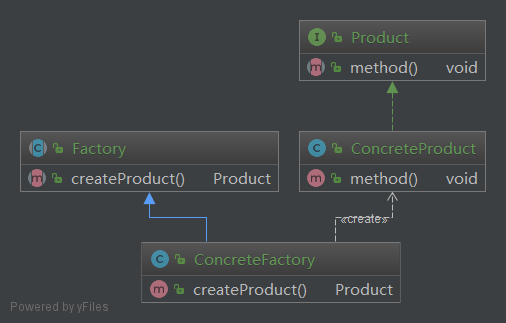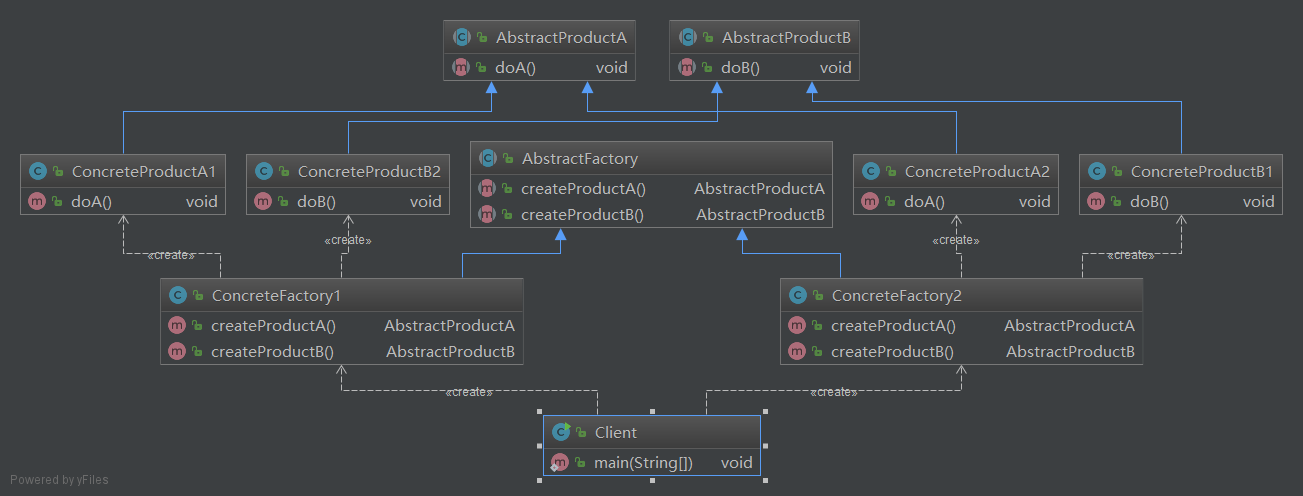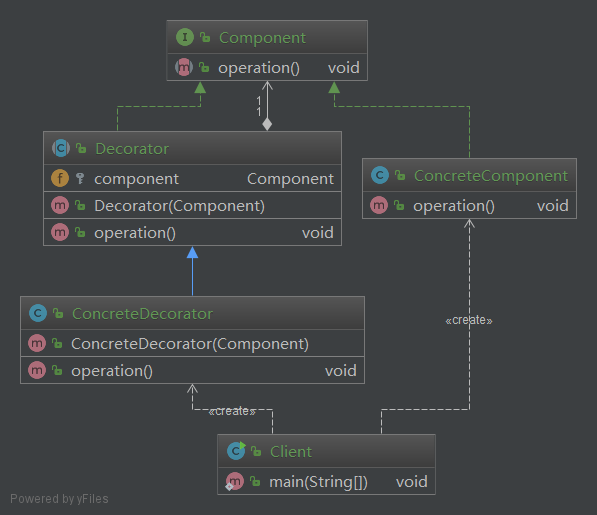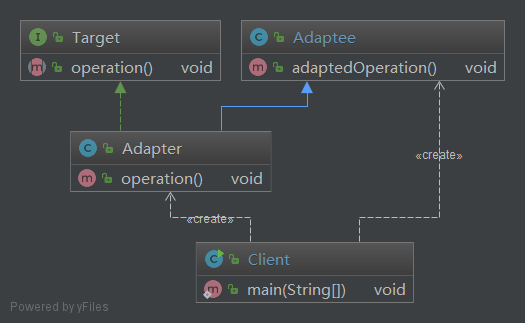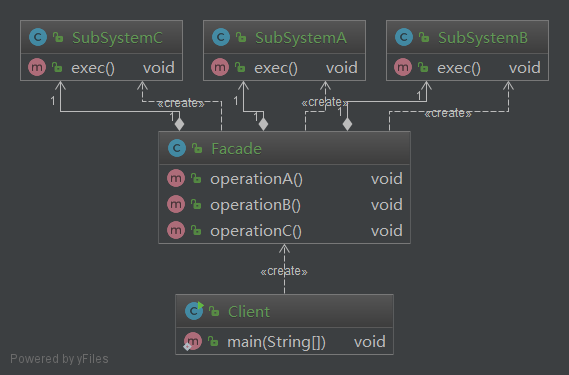DesignPatterns-Kotlin
Design Patterns
- In software engineering, a design pattern is a general repeatable solution to a commonly occurring problem in software design. A design pattern isn't a finished design that can be transformed directly into code. It is a description or template for how to solve a problem that can be used in many different situations.
Creational design patterns
- Singleton
- prototype
- Object Pool
- Factory Method
- Builder
- Abstract Factory
Structural design patterns
- Adapter
- Bridge
- Composite
- Decorator
- Facade
- Flyweight
- Private Class Data
- Proxy
Behavioral design patterns
- Chain of responsibility
- Command
- Interpreter
- Iterator
- Mediator
- Memento
- Null Object
- Observer
- State
- Strategy
- Template method
- Visitor
Creational design patterns
- Singleton
The singleton pattern ensures that only one object of a particular class is ever created. All further references to objects of the singleton class refer to the same underlying instance. There are very few applications, do not overuse this pattern!
UML :
Example:
class Counter private constructor() {
var count = 0
fun addOne() {
count++
}
companion object {
val instance = Counter()
}
}
Usage :
val obj1: Counter = Counter.instance
val obj2: Counter = Counter.instance
obj1.addOne()
obj2.addOne()
println("Counter 1 : ${obj1.count}")
println("Counter 2 : ${obj2.count}")
obj1.addOne()
obj2.addOne()
println("Counter 1 : ${obj1.count}")
println("Counter 2 : ${obj2.count}")
Output :
Counter 1 : 2
Counter 2 : 2
Counter 1 : 4
Counter 2 : 4
prototype
The Prototype pattern delegates the cloning process to the actual objects that are being cloned. The patte![prototype] rn declares a common interface for all objects that support cloning. This interface lets you clone an object without coupling your code to the class of that object. Usually, such an interface contains just a single clone method.
The implementation of the clone method is very similar in all classes. The method creates an object of the current class and carries over all of the field values of the old object into the new one. You can even copy private fields because most programming languages let objects access private fields of other objects that belong to the same class.
An object that supports cloning is called a prototype. When your objects have dozens of fields and hundreds of possible configurations, cloning them might serve as an alternative to subclassing.
UML :
Example:
import java.util.ArrayList
class WordDocument
constructor(var text: String = "", private var images: ArrayList<String> = ArrayList<String>()) : Cloneable {
init {
println("-----Init-----")
}
fun addImage(image: String) = images.add(image)
fun showDocument() {
println("-----Start-----")
println("Text: $text")
println("Images List: ")
images.map {
println("Image name: $it")
}
println("-----End-----")
}
fun cloneTo(): WordDocument? {
try {
val copy: WordDocument = super.clone() as WordDocument
copy.text = this.text
copy.images = this.images.clone() as ArrayList<String>
return copy
} catch (e: CloneNotSupportedException) {
e.printStackTrace()
}
return null
}
}
Usage :
fun main() {
val originDoc: WordDocument = WordDocument().apply {
text = "This is a document"
addImage("Image 1")
addImage("Image 2")
addImage("Image 3")
showDocument()
}
val copyDoc: WordDocument? = originDoc.cloneTo()?.apply {
showDocument()
text = "This is a copy document"
addImage("A new image")
showDocument()
}
copyDoc!!.showDocument()
}
Output:
-----Init-----
-----Start-----
Text: This is a document
Images List:
Image name: Image 1
Image name: Image 2
Image name: Image 3
-----End-----
-----Start-----
Text: This is a document
Images List:
Image name: Image 1
Image name: Image 2
Image name: Image 3
-----End-----
-----Start-----
Text: This is a copy document
Images List:
Image name: Image 1
Image name: Image 2
Image name: Image 3
Image name: A new image
-----End-----
-----Start-----
Text: This is a copy document
Images List:
Image name: Image 1
Image name: Image 2
Image name: Image 3
Image name: A new image
-----End-----
Builder
The builder pattern is used to create complex objects with constituent parts that must be created in the same order or using a specific algorithm. An external class controls the construction algorithm.
UML :
Example:
data class Car
constructor(var color: String, var licensePlate: String, var brand: String) {
private constructor(builder: Builder) : this(
builder.color,
builder.licensePlate,
builder.brand
)
class Builder {
lateinit var color: String
lateinit var licensePlate: String
lateinit var brand: String
fun color(init: Builder.() -> String) = apply { color = init() }
fun licensePlate(init: Builder.() -> String) = apply { licensePlate = init() }
fun brand(init: Builder.() -> String) = apply { brand = init() }
}
companion object {
fun build(init: Builder.() -> Unit) = Car(Builder().apply(init))
}
}
Usage:
val car1 = Car.build {
brand = "Audi"
color = "Blue"
licensePlate = "C88888"
}
println(car1)
Output:
Car(color=Blue, licensePlate=C88888, brand=Audi)
Factory Method
The factory pattern is used to replace class constructors, abstracting the process of object generation so that the type of the object instantiated can be determined at run-time.
UML :
Example:
interface Cake {
fun prepareMaterials();
fun banking();
}
class MangoCake : Cake {
override fun prepareMaterials() {
println("prepare Mango Cream")
}
override fun banking() {
println("Baking ten minutes")
}
}
abstract class Factory {
abstract fun <T : Cake> createProduct(clz:Class<T>): T?
}
class CakeFactory : Factory() {
override fun <T : Cake> createProduct(clz: Class<T>): T? {
var cake: Cake? = null
try {
cake = Class.forName(clz.name).getDeclaredConstructor().newInstance() as Cake
}catch (e : Exception) {
e.printStackTrace()
}
return cake as T?
}
}
Usage :
val factory : Factory = CakeFactory()
val mangoCake = factory.createProduct(MangoCake::class.java)?.apply {
prepareMaterials()
banking()
}
Outpu:
prepare Mango Cream
Baking ten minutes
Abstract Factory
The abstract factory pattern is used to provide a client with a set of related or dependant objects. The "family" of objects created by the factory are determined at run-time.
UML :
Example:
abstract class CakeFactory {
abstract fun cream():CakeCream
abstract fun style():CakeStyle
}
abstract class CakeCream {
abstract fun cream()
}
abstract class CakeStyle {
abstract fun style()
}
class HeartStyle:CakeStyle() {
override fun style() {
println("Heart Style")
}
}
class MangoCream:CakeCream() {
override fun cream() {
println("Mango Cream")
}
}
class MangoHeartCake : CakeFactory(){
override fun cream(): CakeCream {
return MangoCream()
}
override fun style(): CakeStyle {
return HeartStyle()
}
}
Usage :
val mangoHeartCake: CakeFactory = MangoHeartCake()
mangoHeartCake.cream().cream()
mangoHeartCake.style().style()
println("=================")
val mangoSquareCake: CakeFactory = MangoSquareCake()
mangoSquareCake.cream().cream()
mangoSquareCake.style().style()
Outpu:
Mango Cream
Heart Style
=================
Mango Cream
Square Style
Structural Patterns :
Protection Proxy
The proxy pattern is used to provide a surrogate or placeholder object, which references an underlying object. Protection proxy is restricting access.
UML :
Example:
interface IPicker {
fun receiveMessage()
fun takeCourier()
fun signatureAcceptance()
}
class RealPicker:IPicker {
override fun receiveMessage() {
println("Receive text Message")
}
override fun takeCourier() {
println("Take the Courier")
}
override fun signatureAcceptance() {
println("Signature Acceptance")
}
}
class ProxyPicker(private val picker: IPicker) : IPicker by picker
Usage :
val picker:IPicker = RealPicker()
val proxyPicker = ProxyPicker(picker)
proxyPicker.receiveMessage()
proxyPicker.takeCourier()
proxyPicker.signatureAcceptance()
Outpu:
Receive text Message
Take the Courier
Signature Acceptance
Decorator
The decorator pattern is used to extend or alter the functionality of objects at run-time by wrapping them in an object of a decorator class. This provides a flexible alternative to using inheritance to modify behaviour.
UML :
Example:
interface Cake {
fun make()
}
class CakeEmbryo : Cake {
override fun make() {
println("Baking Cake")
}
}
open class DecoratorCake constructor(val cake : Cake): Cake by cake
class FruitCake constructor(cake:Cake) :DecoratorCake(cake) {
override fun make() {
addSomeFruit()
super.make()
}
private fun addSomeFruit() {
println("Add Some Fruit")
}
}
Usage :
val cake: Cake = CakeEmbryo()
cake.make()
println("--------Decorate Fruit Cake--------")
val fruitCake: DecoratorCake = FruitCake(cake)
fruitCake.make()
Outpu:
Baking Cake
--------Decorate Fruit Cake--------
Add Some fruit
Baking Cake
Adapter
The adapter pattern is used to provide a link between two otherwise incompatible types by wrapping the "adaptee" with a class that supports the interface required by the client.
UML :
Example:
interface VoltFive {
fun provideVoltFive():Int
}
class Volt220 {
fun provideVolt220(): Int {
return 220
}
}
class VoltAdapter(private val volt220: Volt220) : VoltFive {
override fun provideVoltFive(): Int {
val volt = volt220.provideVolt220()
return 5
}
fun provideVolt220(): Int {
return volt220.provideVolt220()
}
}
Usage :
val volt220 = Volt220()
val adapter = VoltAdapter(volt220)
val volt = adapter.provideVoltFive()
println("After adapter, the volt is : $volt")
Outpu:
After adapter, the volt is :5
Facade
The facade pattern is used to define a simplified interface to a more complex subsystem.
UML :
Example:
interface Italykitchen {
fun lasagneWithTomatoAndCheese()
fun prawnRisotto()
fun creamCaramel()
}
class ItalykitchenImpl : Italykitchen {
override fun lasagneWithTomatoAndCheese() {
println("Lasagne With Tomato And Cheese")
}
override fun prawnRisotto() {
println("Prawn Risotto")
}
override fun creamCaramel() {
println("Cream Caramel")
}
}
interface Frenchkitchen {
fun bouillabaisse()
fun cassoulet()
fun pouleAuPot()
}
class FrenchkitchenImpl : Frenchkitchen {
override fun bouillabaisse() {
println("Bouillabaisse")
}
override fun cassoulet() {
println("Cassoulet")
}
override fun pouleAuPot() {
println("PouleAuPot")
}
}
class Menu {
private val italykitchen: Italykitchen
private val frenchkitchen: Frenchkitchen
init {
italykitchen = ItalykitchenImpl()
frenchkitchen = FrenchkitchenImpl()
}
fun bouillabaisse() {
frenchkitchen.bouillabaisse()
}
fun cassoulet() {
frenchkitchen.cassoulet()
}
fun pouleAuPot() {
frenchkitchen.pouleAuPot()
}
fun lasagneWithTomatoAndCheese() {
italykitchen.lasagneWithTomatoAndCheese()
}
fun prawnRisotto() {
italykitchen.prawnRisotto()
}
fun creamCaramel() {
italykitchen.creamCaramel()
}
}
Usage :
val menu = Menu()
println("Customer order")
menu.lasagneWithTomatoAndCheese()
menu.creamCaramel()
println("===========New Order==========")
println("Customer two orders")
menu.bouillabaisse()
menu.prawnRisotto()
Outpu:
Customer order
Lasagne With Tomato And Cheese
Cream Caramel
===========New Order==========
Customer two orders
Bouillabaisse
Prawn Risotto



